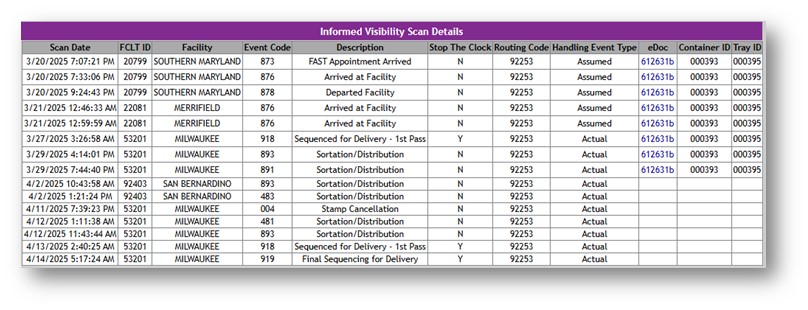Well, I think it’s fascinating.
When you track a lot of mail you start to see patterns in how mail travels and is delivered. Different classes and entry methods have their own patterns. When mail is delayed, these are the patterns we look for to try to figure out the issues. I have a few examples to share with you.
Let’s start with something simple – a First-Class letter. This is not a piece of mail you drop in a mailbox. This is a commercially prepared automated mailing, which is generally what we are tracking. Here’s a typical tracking history for one piece of mail:

The first two scans show where the mail started its journey. We’re looking at the “Event Code” to identify what was happening. The first scan happened on July 25 at 7:43 PM at the Juneau Station (which is in Wisconsin, by the way. This isn’t the Alaska Juneau). The event code was 873, which means the truck was arriving at the facility, delivering on the FAST appointment that was made for the mailing. In this case, a placard on the truck was scanned. The next event, 874, two minutes later, was the scanning of the IMcb (the container barcode) as the pallet was unloaded from the truck. These were both “assumed” scans. The mail piece we’re following was not physically scanned – the truck and pallet our piece is traveling in were, and the eDocs prepared by the mailer provided nesting information, letting the Postal Service know what pieces were in what truck/ container/ tray. The container is there, so it is assumed that the piece of mail is in the container.
There are no additional scans for this mail piece in Wisconsin. A designated tray or pallet was probably routed directly to the next stop, so no further scanning was required.
We next see our mail piece as it arrives in Los Angeles, with an event code of 893. This operation is the first piece sort run in Los Angeles for pieces arriving from another facility. At this point, the piece is out of its tray and being run through a sorter – it’s an “actual” scan. It occurred on July 27 at 11:14 AM, two days after it left Wisconsin. That same evening, Los Angeles moved the piece to the next operation, where the piece is sequenced for delivery. This is a two-pass operation, with event codes 918 and 919. After the 919 operation that occurred late that night at 12:54 AM, the mail was trayed for the carrier, and that tray was delivered to the letter carrier that morning. These again were actual scans, and the last time the mail piece was physically scanned. If the carrier has a piece of mail to be delivered that morning, they will deliver it. We will say that this was delivered that day, July 28. The Postal Service will add one more scan – 517, a “logical” scan which shows that the carrier went to the delivery address, and when. In this case, it appears that it was at 5:38 PM.
No one signs for the letter, but through years of experience, we are very confident that that is indeed the day it was delivered.
So, this was a perfect trip – exactly the events and timing we would hope to see. We have a definitive start-the-clock date, July 25, and it was delivered on July 28. Three-day service from Wisconsin to California. Nice.
Here’s another piece from the same mailing:

It starts out with the same entry events but gets an additional sort in Milwaukee. In that sortation, the piece was recognized as having a change of address on file and was rerouted to Shrewsbury, Massachusetts for address change processing. This mail piece was flagged for address change in Milwaukee on July 26 but didn’t arrive for processing until August 4. Delays in address change processing are not unusual – another good reason to have quality addresses. With, presumably, a new address affixed, it reaches Los Angeles on August 9, and goes through standard processing as the first piece we looked at, and then gets sent to the box section for delivery – event code 896.
In this case, it is likely that the addressee, which was a business, was having its mail forwarded to a PO Box, which is what sent it to address change processing. A good address and knowledge of the customer's delivery preference could have gotten this delivered weeks earlier.
We can tell a lot about how a mailing was handled by looking at the process order. Here’s a piece from a different mailing:

This scan history is for a job that was almost certainly commingled. We don’t see a start-the-clock scan. The first scan we see is a first pass for delivery sequencing, really the next-to-last scan. The mail was commingled and shipped directly to the Birmingham A downtown annex. Only 243 pieces from this mailing are going to Birmingham – not enough to justify a drop ship, so it looks like commingling. As is so often the case with commingling, the mail was processed quickly once it arrived in the local process unit.
All the mail in this next example was dropped in Texas, destined for Texas.

It is marketing mail, but delivered quickly, which is usually the case with local mail. Fast Appointment on June 11, delivered June 13.
Finally, here’s locally entered Marketing Mail:

This mail piece entered in North Carolina on May 29, and was delivered in Tacoma, Washington, on June 2. Not bad for Marketing Mail. We often see marketing mail travel faster than First-Class.
Oh, and sometimes you get one of these…Better call SnailWorks!

As you are reviewing your mail tracking, never hesitate to contact us with any questions. We love this stuff!